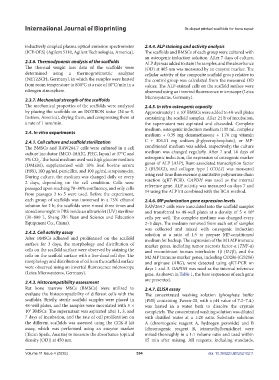Page 362 - v11i4
P. 362
International Journal of Bioprinting Sr-doped printed scaffolds for bone repair
inductively coupled plasma optical emission spectrometer 2.4.4. ALP staining and activity analysis
(ICP-OES) (Agilent 5110, Agilent Technologies, America). The scaffolds and BMSCs of each group were cultured with
an osteogenic induction solution. After 7 days of culture,
2.3.6. Thermodynamic analysis of the scaffolds ALP dye was added to stain the samples, and the absorbance
The thermal weight loss data of the scaffolds were (OD) at 405 nm was measured by an enzyme marker. The
determined using a thermogravimetric analyzer cellular activity of the composite scaffold group relative to
(NETZSCH, Germany), in which the samples were heated the control group was calculated from the measured OD
from room temperature to 800°C at a rate of 10°C/min in a values. The ALP-stained cells on the scaffold surface were
nitrogen atmosphere. observed using an inverted fluorescence microscope (Leica
Microsystems, Germany).
2.3.7. Mechanical strength of the scaffolds
The mechanical properties of the scaffolds were analyzed 2.4.5. In vitro osteogenic capacity
by placing the scaffolds on an INSTRON tester (34 sc-5, Approximately 1 × 10 BMSCs were added to 48-well plates
5
Instron, America), drying them, and compressing them at containing the scaffold samples. After 24 h of incubation,
a rate of 1 mm/min. the supernatant was aspirated and discarded. Complete
medium, osteogenic induction medium (100 mL complete
2.4. In vitro experiments medium + 0.39 mg dexamethasone + 1.76 mg vitamin
2.4.1. Cell culture and scaffold sterilization C + 306.11 mg sodium β-glycerophosphate), or MP-
The BMSCs and RAW264.7 cells were cultured in a cell conditioned medium was added, respectively; the culture
culture incubator (MCO-18AIC, PHC, Japan) at 37°C and medium was changed regularly. After 7 and 14 days of
5% CO . The basal medium used was high glucose medium osteogenic induction, the expression of osteogenic marker
2
(DMEM), supplemented with 10% fetal bovine serum genes of ALP (ALP), Runt-associated transcription factor
(FBS), 100 μg/mL penicillin, and 100 μg/mL streptomycin. 2 (RUNX2), and collagen type I (COL1) was measured
During culture, the medium was changed daily or every using real-time fluorescence quantitative polymerase chain
2 days, depending on the cell condition. Cells were reaction (qRT-PCR). GAPDH was used as the internal
passaged upon reaching 70–80% confluency, and only cells reference gene. ALP activity was measured on days 7 and
from passages 3 to 5 were used. Before the experiment, 14 using the ALP kit combined with the BCA method.
each group of scaffolds was immersed in a 75% ethanol 2.4.6. MP polarization gene expression levels
solution for 2 h; the scaffolds were rinsed three times and RAW264.7 cells were inoculated into the scaffold samples
stored overnight in PBS inside an ultraviolet (UV) sterilizer and transferred to 48-well plates at a density of 5 × 10
4
(30–800 L, Sheng Zhi Yuan and Science and Education cells per well. The complete medium was changed every
Equipment Co., China). 2–3 days. The medium removed from each set of samples
was collected and mixed with osteogenic induction
2.4.2. Cell activity assay solution at a ratio of 1:5 to prepare MP-conditioned
After BMSCs adhered and proliferated on the scaffold medium for backup. The expression of the M1 MP immune
surface for 3 days, the morphology and distribution of marker genes, including tumor necrosis factor-α (TNF-α)
cells on the scaffold surface were observed by staining the and recombinant human interleukin 1β (IL1β), and the
cells on the scaffold surface with a live-dead cell dye. The M2 MP immune marker genes, including CD206 (CD206)
morphology and distribution of cells on the scaffold surface and arginase (ARG), were detected using qRT-PCR on
were observed using an inverted fluorescence microscope days 1 and 3. GAPDH was used as the internal reference
(Leica Microsystems, Germany). gene. As shown in Table 1, the base sequences of each gene
2.4.3. Histocompatibility assessment are presented.
Rat bone marrow MSCs (BMSCs) were utilized to 2.4.7. ELISA assay
evaluate the histocompatibility of different cells with the The concentrated washing solution (phosphate buffer
scaffolds. Briefly, sterile scaffold samples were placed in [PBS] containing Tween-20, with a pH value of 7.2–7.4.)
48-well plates, and the samples were inoculated with 5 × was heated in a water bath to dissolve the crystals
10 BMSCs. The supernatant was aspirated after 1, 3, and completely. The concentrated washing solution was diluted
4
7 days of incubation, and the rate of cell proliferation on with distilled water at a 1:20 ratio. Substrate solutions
the different scaffolds was assessed using the CCK-8 kit A (chromogenic reagent A, hydrogen peroxide) and B
assay, which was performed using an enzyme marker (chromogenic reagent B, tetramethylbenzidine) were
(Tecan Spark, Austria) to measure the absorbance (optical mixed thoroughly in a 1:1 volume ratio and used within
density [OD]) at 450 nm. 15 min after mixing. All reagents, including standards,
Volume 11 Issue 4 (2025) 354 doi: 10.36922/IJB025210211

